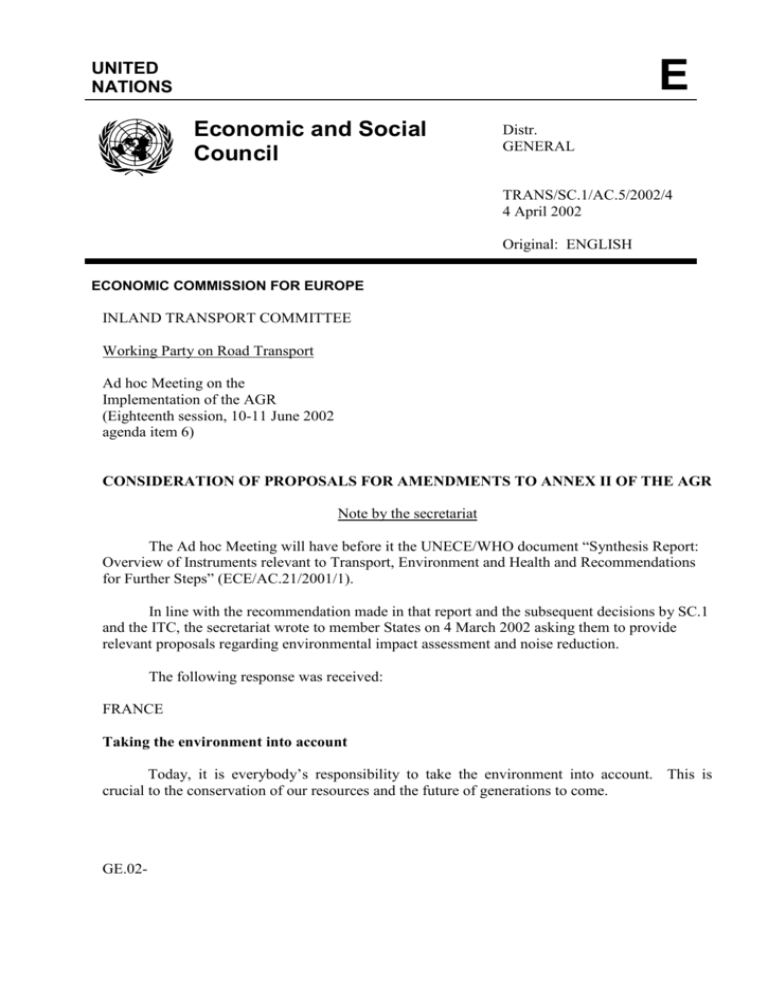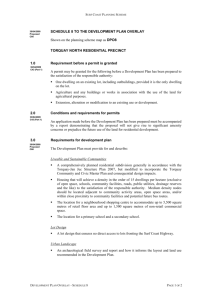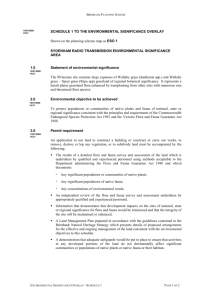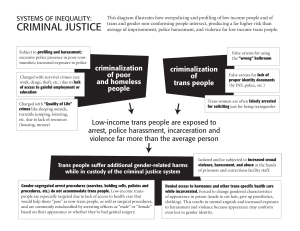UNITED
advertisement

E UNITED NATIONS Economic and Social Council Distr. GENERAL TRANS/SC.1/AC.5/2002/4 4 April 2002 Original: ENGLISH ECONOMIC COMMISSION FOR EUROPE INLAND TRANSPORT COMMITTEE Working Party on Road Transport Ad hoc Meeting on the Implementation of the AGR (Eighteenth session, 10-11 June 2002 agenda item 6) CONSIDERATION OF PROPOSALS FOR AMENDMENTS TO ANNEX II OF THE AGR Note by the secretariat The Ad hoc Meeting will have before it the UNECE/WHO document “Synthesis Report: Overview of Instruments relevant to Transport, Environment and Health and Recommendations for Further Steps” (ECE/AC.21/2001/1). In line with the recommendation made in that report and the subsequent decisions by SC.1 and the ITC, the secretariat wrote to member States on 4 March 2002 asking them to provide relevant proposals regarding environmental impact assessment and noise reduction. The following response was received: FRANCE Taking the environment into account Today, it is everybody’s responsibility to take the environment into account. This is crucial to the conservation of our resources and the future of generations to come. GE.02- TRANS/SC.1/AC.5/2002/4 page 2 The highway is a tool at the service of users, designed in a “land use planning” context. It is dedicated to the movement of persons and goods and provides access to industrial, rest and leisure areas. Provided that environmental concerns have been carefully integrated into road project studies, most of them do not pose any serious problems in this respect, particularly if the road traffic remains light. But if the necessary precautions have not been taken, a road alignment may jeopardise resources that are vital such as water, patrimonial, or natural such as fauna and flora. It is equally difficult to determine the future outlook for a site that has been scarified by earthworks and then polluted by traffic. Each manager must consequently ensure knowledge of the following list of elements. He must then take the appropriate steps to inform users on their preservation through certain instructions or must carry out their physical protection. Physical elements - - topography: knowledge of the basic blueprints of the land; geology: the subsurface, its nature and its structure; pedology: nature of surface soils and their reclaimability; hydrology: interaction of the project with surface water and groundwater flows; water resources and water quality: location and vulnerability of groundwater (wells, catchments, water use); water course characteristics and quality objectives; drainage and treatment of chronic and accidental pollution; air: gaseous pollution and exposure of nearby residential areas: airborne soil pollution; natural and technological hazards: floods (see hydrology), ground and rock movements, underground cavities, avalanches, earthquake hazards, high-risk areas with chemical or nuclear activities, etc. Biological elements - fauna: knowledge of animal life, territories and movements; flora: rare species, ecological value of natural resources, vulnerability. Land use - agriculture, sylviculture; residential areas, facilities, existing and planned buildings; tourism and leisure: hunting, fishing, walking and riding, etc. TRANS/SC.1/AC.5/2002/4 page 3 Noise - knowledge of traffic forecasts and composition (percentage of HGVs); residential area locations and activities; where necessary, relief and topography data. Impact - disturbance of local residents’ sleep and activities (annoyance and health effects). Measures to be taken - Avoid inhabited areas and sensitive activities (schools, hospitals); Provide protection (screens, berms); Install low-noise road surfacings where possible; Provide acoustic insulation of building fronts; Take account of existing noise nuisance in urban planning documents. _______











